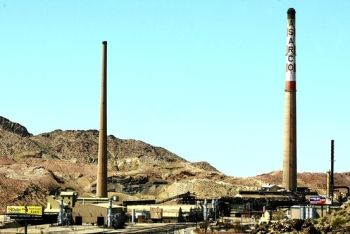
Publisher:
Bonnie King
CONTACT:
Newsroom@Salem-news.com
Advertising:
Adsales@Salem-news.com

~Truth~
~Justice~
~Peace~
TJP
Oct-24-2011 23:03

 TweetFollow @OregonNews
TweetFollow @OregonNews
Lingering Questions Haunt Old Border Smelter
Kent Paterson for Salem-News.comThe legacy of lead, arsenic and other metals contamination in a tri-state region traced to Asarco has long been documented, but questions linger over the complete nature and extent of the pollution.
 Asarco plant overlooking the Rio Grande. Photo: recastingthesmelter.com |
(LAS CRUCES, N.M.) - In a few months, the skyline of El Paso and Ciudad Juarez is set for a dramatic transformation. For generations the smokestacks of the American Smelting and Refining Company (Asarco) have towered hundreds of feet over the Rio Grande, first exemplifying and then symbolizing a bygone industrial economy powered by mineral and metals production. Still flashing into the night, the big stack’s red lights serve as a reminder to borderlanders of a history that goes back to the late 19th century.
But according to US and Mexican authorities, as well as citizen activists in the two nations, Asarco left behind a legacy of pollution and sick residents in El Paso, Ciudad Juarez and Anapra/ Sunland Park, New Mexico.
Shut down since 1999, the old smelter is due for final demolition in early 2012. Project Navigator, the California-based company in charge of demolishing the facility and cleaning it up of environmental contamination, has announced a November 3 public meeting in El Paso to update the community on the project’s progress.
According to Project Navigator’s Roberto Puga, custodial trustee for the demolition/remediation project, work is progressing on various fronts. A Texas bankruptcy court approved a $52 million budget for the project, but sales of Asarco’s on-site inventories are expected to net at least $10 million in additional funds that will be used to help Project Navigator complete its mission, Puga told Frontera NorteSur.
Rezoning the Asarco site earlier this year, the El Paso City Council paved the way for re-development of land that is located only minutes from the University of Texas at El Paso (UTEP), downtown El Paso and a possible future border crossing in Sunland Park.
In short, the old Asarco property is a potentially hot piece of real estate.
The legacy of lead, arsenic and other metals contamination in a tri-state region traced to Asarco has long been documented, but questions linger over the complete nature and extent of the pollution. For example, a group of former Asarco workers has contended that oil containing highly-polluting PCBs was burned in a company furnace.
A local attorney working with the ex-Asarco employees, Veronica Carbajal of Rio Grande Legal Aid, raised the possibility that dioxins and furans could also have been released into the environment, in a letter sent to Puga this year.
In remarks to Frontera NorteSur, Heather McMurray, member of the Sunland Park Environmental Grassroots Group, was critical of the planned demolition’s timetable. McMurray said fundamental questions remain unanswered about the identity of other substances illegally incinerated at the Asarco plant from about 1991 to 1998, a practice which resulted in an EPA consent decree against the big mining and mineral company.
McMurray has been urging the EPA to speed up responses to Freedom of Information Act requests on the 90s’ hazardous waste operation. Based on existing evidence, she insisted that radioactive materials were among the waste shipments that went to El Paso Asarco.
“(Asarco) is not going to be safe, even if it is paved over,” McMurray said. “Asarco disposed of man-made and naturally-occurring radioactive material.”
The smelter site where the hazardous waste was incinerated is very close to UTEP and its surrounding neighborhoods and just across the Rio Grande from low-income colonias in Ciudad Juarez.
Both Carbajal and McMurray have also cited the Asarco site’s potential impact on groundwater and the adjacent Rio Grande, which supplies both El Paso and Ciudad Juarez with drinking water.
Sam Coleman, director of EPA Region Six’s Superfund division, said his agency is reviewing documents related to the waste incineration operation but is negotiating with what remains of Asarco over the issue of confidential business information. According to Coleman, current law provides penalties including fines and jail time for federal officials who release proprietary business information.
“We’re not going to do that,” Coleman stressed. The EPA official said the environmental agency is “trying to make public as many as the documents as possible” but that the “process takes time.”
For perhaps the last times, the Paso de Norte community will have a pair of upcoming opportunities to publicly question and discuss the future of the old Asarco smelter.
The first date is Project Navigator’s meeting on November 3, between 5-7 p.m. in the El Paso Downtown Public Library at 501 N. Oregon St. According to Puga, engineers from his company will give presentations to an audience that is expected to consist of representatives of local elected officials, environmental regulatory agencies and the public-at-large. A similar meeting last year drew about 100 people, Puga said.
The EPA’s Sam Coleman also welcomed the public to bring their issues to a November 9 Border 2020 meeting also scheduled for El Paso. Although Border 2020 is designed as a general, cooperative environmental improvement program between the US and Mexico, Coleman said all relevant issues were “fair game” for public airing.
Frontera NorteSur: on-line, U.S.-Mexico border news
Center for Latin American and Border Studies
New Mexico State University
Las Cruces, New Mexico
Articles for October 23, 2011 | Articles for October 24, 2011 | Articles for October 25, 2011


Quick Links
DINING
Willamette UniversityGoudy Commons Cafe
Dine on the Queen
Willamette Queen Sternwheeler
MUST SEE SALEM
Oregon Capitol ToursCapitol History Gateway
Willamette River Ride
Willamette Queen Sternwheeler
Historic Home Tours:
Deepwood Museum
The Bush House
Gaiety Hollow Garden
AUCTIONS - APPRAISALS
Auction Masters & AppraisalsCONSTRUCTION SERVICES
Roofing and ContractingSheridan, Ore.
ONLINE SHOPPING
Special Occasion DressesAdvertise with Salem-News
Contact:AdSales@Salem-News.com



Terms of Service | Privacy Policy
All comments and messages are approved by people and self promotional links or unacceptable comments are denied.
[Return to Top]
©2026 Salem-News.com. All opinions expressed in this article are those of the author and do not necessarily reflect those of Salem-News.com.